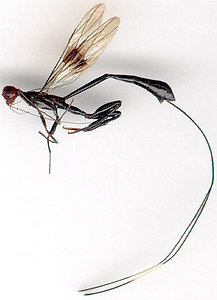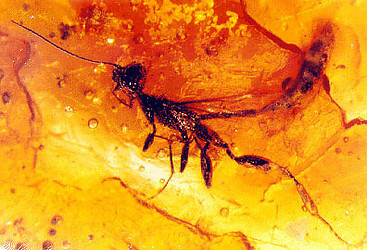

















Unguiculate, claviculate placental mammals, with orbits encircled by bone, three kinds of teeth, at least at one time of life; brain always with a posterior lobe and calcerine fissure; the innermost digit of at least one pair of extremities opposable; hallux with a flat nail or none; a well developed caecum; penis pendulous; testes scrotal; always two pectoral mammae.
Preservation of generalised limb structure with primitive pentadactyly (five fingers). Enhancement of free mobility of the digits, especially of the pollex and hallux (both used for grasping). Replacement of sharp, compressed claws by flat nails; development of verysensitive tactile pads on the digits. Progressive shortening of the snout. Elaboration of the visual apparatus, with development of varying degrees of binocular vision. Reduction of the olfactory apparatus. Loss of certain elements of the primitive mammalian dentition. Preservation of a simple molar cusp pattern. Progressive expansion and elaboration of the brain especially of the cerebral cortex. Progressive and increasingly efficient development of gestational processes.
Well developed, divergent hallux with flat terminal phalanx in the foot. Elongated distal segment of the calcaneus. Relatively large, convergent orbits with restricted interorbital distance. Postorbital bar present; ethmoid exposure in the orbit possible (depending in interorbital distance relative to skull size). Petrosal bulla. Relativly large braincase. Sylvian sulcus on endocast. Dental formula maximally 2.1.3.3/2.1.3.3. Premaxilla short; upper incisors arranged more trnsversly than longitudally. Molars with low, rounded cusps. Lower molars with raised, enlarged talonids.
“Sequencing of the complete genome in humans, fruit flies, nematodes and plants has revealed that the number of protein-coding genes is much more similar among these species than expected,” he says. “Curiously, the largest differences between major species groups appear to be the amount of ‘junk’ DNA rather than the number of genes.”
Using a recently developed population genetic approach, Andolfatto showed in his study that these expansive regions of “junk” DNA—which in Drosophila accounts for about 80 percent of the fly’s total genome—are evolving more slowly than expected due to natural selection pressures on the non-protein-coding DNA to remain the same over time.
“This pattern most likely reflects resistance to the incorporation of new mutations,” he says. “In fact, 40 to 70 percent of new mutations that arise in non-coding DNA fail to be incorporated by this species, which suggests that these non-protein-coding regions are not ‘junk,’ but are somehow functionally important to the organism.”

At the Edinburgh Zoo the chimps make high grunting noises when they find bread, a food they seem to like, and low grunting sounds when they find apples, which they apparently don't care for very much, according to the study, published last week in the journal Current Biology.
After noting the different types of grunts, the researchers set out to see if other chimps listening to the grunts interpreted them the way the researchers had ("bread" and "apple"). The researchers found that the listening chimp did seem to understand what the grunts mean.
The scientists recorded the grunts and played them to a chimp in the pen. When the chimp heard the "bread" grunt, the ape looked in the place in the pen where bread is usually found. When the "apple" call was played, the chimp searched appropriately for an apple.
"It shows that, by simply listening to each other's calls, chimpanzees can infer what kind of food the caller has found," said researcher Katie Slocombe, who worked with colleague Klaus Zuberbuhler on the project.
"We don't know yet how specific these calls are—i.e., whether they specifically refer to bread or apples or whether they simply label highly preferred food [such as bread] and less preferred food types [such as apples]. We are planning further experiments to test these two possibilities," Slocombe said.
Study co-author Zuberbuhler believes that the grunts serve a social function, since the chimps hardly ever make the noises when they are eating alone.
The grunts may be a call to dinner, Zuberbuhler says. "Chimps may find it genuinely unpleasant to eat without others doing the same."
The possible dinner-bell grunts may be related to certain human vocalizations, Zuberbuhler said.
"We don't like to eat in the presence of others who are not eating," he said.
"In many cultures humans coordinate the timing of starting a meal, for example, with vocal cues such as 'bon appetit.'"
The seven nearby sites include an extensive cemetery and represent one of the largest and best preserved concentrations of ancient skeletons and artifacts ever found in the region, researchers say.
"...the desert has waxed and waned since the last Ice Sge to eventually become the expanding desert we know today."
As the lakes evaporated and disappeared 6,000 years ago, the people that had based their livelihood on its aquatic life, the Kiffians, were replaced by the first pastoralists of the Sahara, the Tenereans. This next group of people tended herds of just-domesticated African cattle on the grasslands between the encroaching dunes. These cattle herders, the Tenereans, lived from about 5,500 to 3,500 years ago. Our site contains their tools and ceramics, including beautifully made green stone disk-shaped axes. All of these transitions were happening before the first pyramid in Egypt was ever constructed.
The site may not have been continuously occupied. But it was likely inhabited for much of that time, which was a crucial one in early human history.
During the New Stone Age, humans moved from hunter/gatherer societies to become early agrarians who domesticated plants and animals.
Tools such as large pottery and heavy grinding stones suggest that Kiffian peoples may have occupied the ancient lakeside area at least semi-permanently, Garcea says.
Scientists know that by about 6,300 years ago the Sahara's first pastoral people, the Tenereans, began tending herds of newly domesticated cattle.
And while the expedition team found remains of domestic cows and asses, researchers are uncertain whether Tenerean peoples occupied the particular dig site.
The team says the site's human remains were most striking. Members found hundreds of skeletons in the site's large cemetery, some still adorned with ancient jewelry.
The researchers found tools, such as precision stone blades, bone hooks, pottery stamps, and other artifacts, in graves and other site locations.
Some artifacts suggest travel and perhaps even distant trade. Stone tools made of pale green volcanic rock could have their source some 50 miles (80 kilometers) distant in the Air Mountains, an area rich with period rock art.
But archaeologists are not the only ones who have visited the historic site. Niger is a poor nation, and the temptation to profit from its rich cultural history has proven too great for some.
"We followed some 4x4 tracks that our guides said were definitely not made by tourists but by vendors going out there for stolen artifacts," Sereno said. "A photographer with our team estimates that he photographed as many as 3,000 artifacts in one day, found in shops of communities near the site."
"The wind is destroying these sites very quickly," Garcea, the Italian archaeologist, said. "I saw pictures that [Sereno] took in 2003, and you can really see the deflation."
"Some skeletons that were covered are now exposed to the surface and the hyper-arid desert conditions. In two or three years I'm sure I won't be able to see some of the things that we can study now," she added.

The size of Shakespeare's London, Teotihuacán was built by an unknown people almost 2,000 years ago. The site sits about 25 miles (40 kilometers) north of present-day Mexico City. Temples, palaces, and some of the largest pyramids on Earth line its ancient main street.
Scientists believe Teotihuacán was the hub of trade and commerce in Mesoamerica until the city's civilization collapsed around A.D. 650. When the Aztecs stumbled upon the metropolis centuries later, they dubbed it the "City of the Gods," because they believed it was where the Gods met to create the present universe and sun.
Excavations also reveal that the pyramid was constructed in seven stages, each stage an enlargement of the last. The work started in A.D. 100 and ended around A.D. 400.
Sugiyama has made some intriguing finds, including dozens of beheaded people with bound hands. The bodies suggest bloody sacrificial rituals ripe with symbolism of military power, he said.
Analyses by Spence of the University of Western Ontario suggest the sacrificed victims came from outside Teotihuacán, possibly as captives brought back from distant territories or battles.
The clues come from oxygen isotopes in bones, which act as geological markers. "They tell you where a person was at a particular time," he said.
Climate and altitude are among factors that affect the isotopes. The isotopes found in remains of pyramid victims differ from those unearthed in city homes.
"Basically growth stops as the body concentrates on survival and repair," he said. "Then as the stress passes, the growth continues again. But there's a line left in the tooth that represents the stress episode."
Because teeth only grow during childhood, scientists can put a general age to when the stress happened. These signatures of bodily stress remain in adult teeth.
"We have shown that in the last century of the city there is a growing problem of some sort. We get more and more indications showing up in adult teeth," he said.
Spence, however, says the evidence suggests to him the fires were set during an internal revolt.
According to his theory, the deteriorating health of the city's poor was likely exacerbated by a drought or a disruption to the food supply. This spurred a revolution against the ruling elite and their symbols of power—temples, pyramids, and palaces.
"The destruction seems to have skipped the vast majority of the city and focused on the elite and punished the elite. That suggests a revolt to me," he said.

The new palaeontology department will have space for 46 students, as well as a hi-tech laboratory to analyse fossils.
The head of the new unit, Dr Mackaye Hassane Taisso, set out his ambitions for the future.
"Listen, Toumaï is seven million years old, so our ambition is to find something older," he told the BBC.
"If we find a fossil about 10 million years old, that would be great. We are placing the bar very high, but we need to."


Stephanids live mostly in tropical forests, but many inhabit desert or semidesert areas ..., reach high latitudes (e.g., Megischus bicolor in Canada, Stephanus serrator in Germany, Hemistephanus artiosulcatus in Argentina), or are endemic in many oceanic islands throughout the world. The genera are normally restricted to one or two particular zoogeographical regions, such as Hemistephanus (Neotropical), Parastephanellus (Oriental and Australian), and Foenatopus (mostly Oriental and Afrotropical). No stephanid species, except for one introduced taxon, has been found in more than one zoogeographic region, suggesting a considerable degree of endemism ... There are no species of stephanids known from Chile.
Adults seem to be predominantly diurnal, but some species are attracted to light traps ..., suggesting that flight activity may start in, or extend to crepuscular hours. Flight and other movements are usually slow and weak, but cryptic coloration and behavior contribute to make many species inconspicuous in their habitat.
"...all living organisms have to transport energy obtained from food they eat to support the working of their internal organs, such as the brain or heart. The larger the organism, the further away are the organs from the body surface. “This makes energy supply more and more difficult for larger organisms,” he said. “For example, bacteria have to transport the obtained food over less than one micron, which is their body length, while the distance between an elephant's trunk and an organ such as its brain or heart is about ten million times longer."
But a new study led by Bai-Lian Li, professor of ecology at UC Riverside, shows that this is true only for organisms that are closely related evolutionarily and have body masses differing by no more than 6-7 orders of magnitude – about the difference in body mass between an elephant and a shrew.
For a pair of organisms that don't meet these conditions, that is, organisms that are not closely related evolutionarily and whose body mass difference exceeds the 6-7 orders of magnitude range, the researchers find that the small organism consumes about the same amount of energy per unit mass as the large organism: 1-10 watts per kilogram of body mass in the resting state of the organisms.
"...elephants, ..., appear to be capable of supplying their tissues at a rate similar to that of tiny bacteria."
The researchers’ analysis also shows that the rate of energy consumption per unit body mass declines with growing body size in groups of evolutionarily close organisms, such as mammals. For example, one gram of an elephant’s body uses up 25 times less energy than does one gram of a shrew’s body, accounting for why shrews have to eat more often than elephants. On the other hand, a bacterium, which is not closely related to an elephant in an evolutionary sense, consumes approximately the same energy per unit body mass as the elephant.
So far, life scientists have held the view that the properties of living organisms are shaped by the changing external physical environment to which the organisms must continuously adapt. The new study posits, however, that living organisms are able to overcome the physical limitations imposed on them by their own physical properties and their external environment in order to maintain optimal, biochemical characteristics, such as the mass-specific metabolic rate the researchers studied.



Osedax worms are about 1-2cm in length.
A scanning electron micrograph shows up remarkable detail in the North Sea worm
They root themselves to the whale bones which they then plunder for oils with the help of symbiotic bacteria. The worms' flower-like plumes pull oxygen from the water.
Their reproductive system is extraordinary - certainly in the case of the Pacific Osedax.
"The female Pacific worms keep males inside their tube as a sort of little harem that fertilises eggs as they are released into the water column," explained Dr Glover.
"We're not sure what's happening with the reproductive biology of the Swedish worms yet. We've only got females; we haven't found any males. It's a bit weird."
Scientists have established that all of the Osedax species so far identified appear to be closely related to vestimentiferan tubeworms, which are found only at the volcanic cracks in the ocean floor called hydrothermal vents.
What concerns researchers is that the commercial hunting which so devastated whaling populations would also have severely curtailed this activity by reducing the incidence of whale fall.
It may even have led to the extinction of some bottom-dwelling organisms that depended on this rare but concentrated nutrient supply.
The tracks are embedded in a layer of rock known as the Middle Jurassic Bajocian Gypsum Spring Formation, a 165- to 167-million-year-old rock formation that contains fossilized remains of a marine shoreline and tidal flats. Geologists believe an inland sea, called the Sundance Sea, covered Wyoming, Colorado and a large area of the western United States during the Jurassic period from about 165 million years ago to 157 million years ago.
Debra Mickelson of CU-Boulder’s geological sciences department said the research team identified the tracks of the six-foot-tall, bipedal dinosaur at a number of sites in northern Wyoming, including the Bighorn Canyon National Recreation Area. “It was about the size of an ostrich, and it was a meat-eater,” she said. “The tracks suggest it waded along the shoreline and swam offshore, perhaps to feed on fish or carrion.”
The dinosaur does not have a name, although Mickelson is continuing to look for bones and other remains that could be used to identify and name the new species. “This dinosaur is similar to a Coelosaur,” she said. “It is a dinosaur with bird-like characteristics and is a possible ancestor of birds. It lived in a much earlier time period and was very different from larger dinosaurs like T-Rex or Allosaurus.”
The tracks are of different sizes and were deposited at about the same time, according to Mickelson, revealing that the dinosaurs likely traveled in packs and exhibited some variation in overall size. “Further research into the geologic record and depositional history of the region supports our conclusion that the dinosaurs were intentionally swimming out to sea, perhaps to feed,” she said.
Such exceptional assemblages were thought to have been preserved in environments that were unusually low in oxygen, highly saline, very cold, or extremely dry. What was not suspected until the new compilation was the global distribution of other exceptional fossil deposits of the same ages. Independent estimates of atmospheric pollution crises come from studies of carbon anomalies, microscopic pores of fossil leaves and climatic indicators from fossil soils. Methane outbursts from volcanically intruded coals and submarine gas hydrates are prime suspects for these lethal atmospheric pollution events.
"Lowered levels of oxygen can kill fish and other creatures in marginally aerated environments, and also preserve their carcasses from dismemberment and decay," said Retallack. "Data from carbon anomalies and microscopic leaf pores indicate that some of these killer greenhouses ramped up, within only a few thousand years, to intolerable levels of more than 10 times the modern level of atmospheric carbon dioxide. What stopped them from continuing on to a sterile greenhouse atmosphere like that of Venus? It was the widespread death and burial of animals and their carbon which created fossil bonanzas, the likes of which may have saved us from the heat sterilization experienced by our sister planet."


"...analyses of the teeth of the two species clearly place them as members of a group called parapithecoids, known as "stem" anthropoids because they constitute the species of early creatures from which the subsequent "crown" anthropoid line arose. "The finding of these parapithecoids from such an ancient time confirms that crown anthropoids -- a group including all modern anthropoids -- have their earliest known beginnings in Africa," said Simons. "They show that findings by other researchers of isolated examples of possible higher primate fossils in Asia do not constitute evidence of an ancestral crown anthropoid lineage there."
"...a tooth root from the species Biretia megalopsis is truncated, indicating that it had to make room for the larger eyesocket of a nocturnal animal."
"These finds seem to indicate that Biretia megalopsis must have had very large eyes, and so was likely nocturnal," said Seiffert. "This has never been documented in an early anthropoid. The simplest explanation is that Biretia's nocturnality represents an evolutionary reversal from a diurnal ancestor, but that conclusion is based solely on the probable pattern of relationships. If down the road we find out that our phylogeny was wrong, Biretia could end up being very significant for our understanding of the origin of anthropoid activity patterns."
"NASA's Spitzer Space Telescope has shown complex organic molecules called polycyclic aromatic hydrocarbons (PAHs) are found in every nook and cranny of our galaxy. While this is important to astronomers, it has been of little interest to astrobiologists, scientists who search for life beyond Earth. Normal PAHs aren't really important to biology," Hudgins said. "However, our work shows the lion's share of the PAHs in space also carry nitrogen in their structures. That changes everything."
"Much of the chemistry of life, including DNA, requires organic molecules that contain nitrogen," said team member Louis Allamandola, an astrochemist at Ames. "Chlorophyll, the substance that enables photosynthesis in plants, is a good example of this class of compounds, called polycyclic aromatic nitrogen heterocycles, or PANHs. Ironically, PANHs are formed in abundance around dying stars. So even in death, the seeds of life are sewn," Allamandola said.

Evarcha culicivora, is found only around Lake Victoria in Kenya and Uganda. A species of jumping spider, or salticid, it usually hunts insects on tree trunks and buildings. It stalks its prey rather than trapping it in a web.
Lab experiments conducted near Lake Victoria showed the spider preferred female mosquitoes fed with human blood over all other prey, including male mosquitoes, which don't feed on animal blood.
Tests of the spider's prey preferences showed it went for blood-engorged female mosquitoes in 83 percent of cases when offered a choice of two similar-size insects.
When it came to making a choice based on smell alone, with the two meal options hidden from view, around 90 percent of jumping spiders selected the blood-filled mosquito.
Although many spiders have relatively poor eyesight—those that use webs to trap prey have no need for acute vision, Nelson says—jumping spiders are an exception.
"Salticids are predators that actively search for prey and mates and typically do not build webs," she said. "They have evolved eyes that support high-acuity vision suited to their active lifestyle."
Spiders don't have the skin-piercing mouth parts needed to feed directly on human blood, but the mosquito-munching jumping spider appears to have got around this. The strategy has other advantages as well, Nelson points out.
"Blood-feeding is a dangerous activity," she said. "Animals that are bitten have a swatting response, and often the insect is killed."
The study team suspects a blood meal is also biologically important to E. culicivora.
They say spiders expend a lot of energy breaking solid food down into liquid by injecting their prey with digestive enzymes.
"Perhaps blood is a ready-made, nutrient-rich liquid meal," Nelson said.
Robinson said that governors who order flags flown at half-staff in response to a soldier being killed while serving the country as opposed to the state are in violation of the law, according to general counsel Terry M. Jarrett's interpretation.
Two St. Louis anti-war activists are challenging Gov. Matt Blunt to respond to the deaths of soldiers as several other states do: by flying flags at half-staff when a soldier from the state dies in the line of duty.
Several other governors, including Illinois', issue such orders when soldiers from their states are killed. But Jessica Robinson, Blunt's press secretary, said Wednesday that neither Blunt nor any other governor had the authority to make such an order.
"As a veteran, Gov. Blunt deeply respects the sacrifices and has personally mourned the loss of those who have been killed in action," Robinson said. "But lowering the flags would actually be contingent on a presidential directive. ... Our general counsel's interpretation of the law is that the opportunity and authority rest with the governor when it's (a situation involving) state service and with the president when it's federal service."
Joyce Doody, executive director of the National Flag Foundation in Pittsburgh, said governors do have the authority to order flags flown at half-staff. If asked, however, her organization suggests governors opt to fly state flags instead of U.S. flags so that the U.S. flag isn't too often at half-staff.
Her organization has not tallied how many states fly flags at half-staff in response to the deaths of soldiers. A review of news releases and articles shows that Illinois, California, Michigan, New Mexico, New Jersey, Kentucky, Oregon, Minnesota, Wisconsin, Indiana, Vermont and Pennsylvania are among the states whose governors have ordered either U.S., state or both flags to be flown at half-staff in response to the deaths of soldiers.
Gerardo Cardenas, a spokesman for Blagojevich, said the governor had the authority to make the proclamation because he is commander in chief of the state's National Guard.
"This does not constitute any violation or any trespassing on presidential authority," Cardenas said. "This is a gesture that shows our respect for these soldiers who give up their lives ... We're respecting their sacrifice and honoring their service in a proper way."
WASHINGTON (AP) -- Tom DeLay deliberately raised more money than he needed to throw parties at the 2000 presidential convention, then diverted some of the excess to longtime ally Roy Blunt through a series of donations that benefited both men's causes.
When the financial carousel stopped, DeLay's private charity, the consulting firm that employed DeLay's wife and the Missouri campaign of Blunt's son all ended up with money, according to campaign documents reviewed by The Associated Press.
The government's former chief election enforcement lawyer said the Blunt and DeLay transactions are similar to the Texas case and raise questions that should be investigated regarding whether donors were deceived or the true destination of their money was concealed.
Hartley said he saw no similarity to the Texas case. The fact that DeLay's charity, Christine DeLay's consulting firm and Blunt's son were beneficiaries was a coincidence, Hartley said.
Much of the money - including one donation to Blunt from an Abramoff client accused of running a "sweatshop" garment factory in the Northern Mariana Islands - changed hands in the spring of 2000, a period of keen interest to federal prosecutors.
Noble said investigators should examine whether the pattern of disguising the original source of money might have been an effort to hide the leaders' simultaneous financial and legislative dealings with Abramoff and his clients.
"You see Abramoff involved and see the meetings that were held and one gets the sense Abramoff is helping this along in order to get access and push his clients' interest," he said. "And at the same time, you see Delay and Blunt trying to hide the root of their funding.
The DeLay group began transferring money to Blunt's group in two checks totaling $150,000 in the spring of 2000, well before Republicans actually met in Philadelphia for the convention. The transfers accounted for most of money Blunt's group received during that period.
DeLay's convention arm sent $50,000 on March 31, 2000. Eight days later, the Blunt group made a $10,000 donation to DeLay's private charity for children on April 7, 2000, and began the first of several payments totaling $40,000 to a northern Virginia-based political consulting firm formed by DeLay's former chief of staff, Ed Buckham.
That consulting firm at the time also employed DeLay's wife, Christine, according to DeLay's ethics disclosure report to Congress.
Hartley said Blunt was unaware that Mrs. DeLay worked at the firm when he made the payments, and that she had nothing to do with Blunt's group.
On May 24, 2000 - just before DeLay left with Abramoff for the Scottish golfing trip - DeLay's convention fundraising group transferred $100,000 more to Blunt's group. Within three weeks, Blunt turned around and donated the same amount to the Missouri Republican Party.
The next month, the state GOP began spending large amounts of money to help Blunt's son, Matt, in his successful campaign to become Missouri secretary of state. On July 25, 2000, the state GOP made its first expenditure for the younger Blunt, totaling just over $11,000. By election day, that figure had grown to more than $160,000.
Hartley said Blunt always liked to help the state party and the fact that his son got party help after his donation was a coincidence. "They are unrelated activities," he said.
Exchanges of donations occurred again in the fall. Just a few days before the November election, DeLay's ARMPAC gave $50,000 to the Missouri GOP. A month later, the Missouri GOP sent $50,000 to DeLay's group.
Up late
Well technically I woke up early and can't get back to sleep. This blog will be about science, politics and whatever else I can think of to say.
I was looking at various blogs and came across one that had the Book Meme. It looked like a lot of fun so while I was posting it on my own blog, I tracked it back several blogs. Anyway, I found this in one of the comment sections Good grief, there are 987 different posts referencing "page 123" in Technorati...
PSoTD | Email | Homepage | 02.17.05 - 9:28 pm | #
I clicked on that comment and one of the links was yours.

Since atoms are made up mostly of empty space, with electrons "orbiting" the nucleus at distances typically many hundreds of times its diameter, it seemed reasonable to ask whether the electrons would be dragged away from the nucleus by the stretching of space. Price decided to examine the simplest system, that of a hydrogen atom, with one negative electron orbiting a positive proton. He found if the force involved - electromagnetic in the case of atoms - binding the system together is stronger than a certain critical value, the system will be entirely unaffected by the cosmological expansion.
"This means that the solar system - which is quite tightly bound by gravity - doesn't expand. Your desk doesn't expand. Your dog doesn't expand," says Price. "But clusters of galaxies, which are only loosely bound by gravity, will feel this effect."
Price also found that the atoms never experience just a little stretching - either they must totally ignore the expansion of the universe or they will be completely torn apart. "This all-or-nothing effect is a startling result," says Roy Maartens, a cosmologist at the University of Portsmouth in the UK. "This question has been knocking around since the 1930s, but nobody has found this before."
Andrew Jaffe, an astrophysicist at Imperial College London in the UK believes the effect becomes interesting in so-called "big rip" cosmologies in which the universe is not only expanding, but the expansion is accelerating.
"Price's calculation still holds in this case, but you start to see the opposite effect," says Jaffe. The expansion of the universe accelerates drastically. First it overpowers gravity, ripping apart solar systems, and next the electromagnetic forces are overwhelmed. "The planets are torn apart, and then you and me, and finally the atoms that make us up are destroyed," says Jaffe. "That's not a particularly fun way to end."







